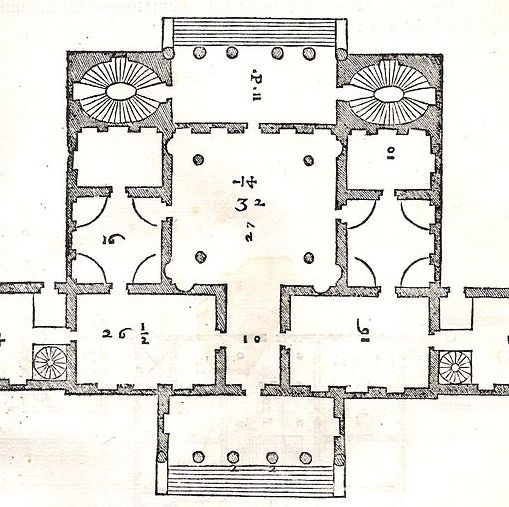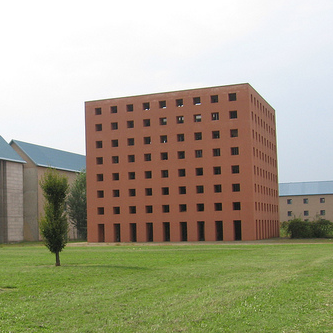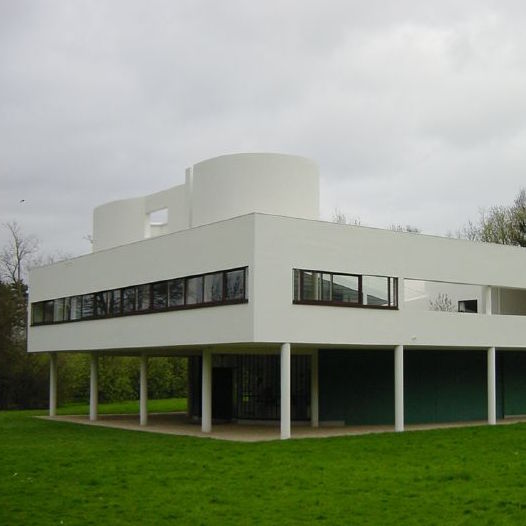The Architectural Imagination: Introduction to the History & Theory of Architecture
- K. Michael Hays, Eliot Noyes Professor of Architectural Theory
- Erika Naginski, Professor of Architectural History
- Antoine Picon, G. Ware Travelstead Professor of the History of Architecture and Technology
- Lisa Haber-Thomson, Design Critic in Architecture
Brief Course Description
Architecture engages a culture's deepest social values and expresses them in material, aesthetic form. In this course, you will learn how to "read" architecture as a cultural expression as well as a technical achievement. Vivid analyses of exemplary buildings from a wide range of historical contexts, coupled with hands-on exercises in drawing and modeling, bring you close to the work of an actual architect or historian.
Architecture is one of the most complexly negotiated and globally recognized cultural practices, both as an academic subject and a professional career. Its production involves all of the technical, aesthetic, political, and economic issues at play within a given society. Over the course of ten modules, we'll examine some of history’s most important examples that show how architecture engages, mediates, and expresses a culture's complex aspirations.
See Course Structure for a full description.
What You Will Learn
- How to read, analyze, and understand different forms of architectural representation
- Social and historical contexts behind major works of architecture
- Basic principles to produce your own architectural drawings and models
- Pertinent content for academic study or a professional career as an architect
Schedule and Effort Hours
The Architectural Imagination is a self-paced ten-module course.
The ten-module course is designed to take approximately 50 hours to complete, including design projects. This total is based on an estimated average of five hours per module. This average is based on the following estimates:
- A lecture of 30-60 minutes
- Exercises requiring 2-4 hours
- Suggested readings are optional and are not included in the time estimate
These are estimates. You should expect to spend more or less time depending on the specific module.
EdX and HarvardX do not offer academic transcripts. We recommend printing either this syllabus or the course About page if you need a record of the estimated effort hours for the course. (An edX verified certificate does not include this information.)
Assignments and Grading
Your grade is based on your performance on course exercises.
There are two types of exercises in the course:
- Concept Checks (short automatically graded questions) are worth 25% of your total grade. (Your lowest Concept Check score will be dropped.)
- Self-Assessments (longer open responses that you then grade yourself) are worth 75% of your total grade. (Your lowest Self-Assessment score will be dropped.)
These exercises are module-specific and are spread throughout the course; there are no exams. A full list of exercises appears below.
There are no specific due dates. You have until the course closes to complete the exercises.
You can find your current grade on the Progress page.
Feature-Based Enrollment
Some content in edX is available only to learners who have purchased a verified certificate. Locked content is marked with a lock icon, as shown to the right. Click the image to see a full-sized version. If you are using screen reader software, you will hear "Content available only to verified-track learners."
When you see this icon, it indicates there are one or more graded assignments on this page. Verified learners will be able to see and complete these assignments, which will count toward their certificate of completion.
NOTE: Graded exercises in Part 1 (the first four modules) have been provided for all learners. Starting in Part 2, graded exercises will be available to verified track learners only.
In addition, audit learners will lose access to the course after a certain number of weeks. The length of time varies by course, and is noted on the course signup page at edX.org. This time is counted from when you enroll or from when the course begins, whichever is later. Verified learners retain course access indefinitely.
If you have questions, please use the Contact Us link here or at the bottom of the page.
Language Policy
Is English required?
English is the official language of the course in that all materials are in English and the course team is English speaking.
Posting in English is recommended if you are looking for the course team to post a response.
A language other than English can be used for the Self-Assessments. Ultimately, you are the evaluator of your work, so the method of response should be whatever allows you to learn best.
Assignment Outline
Part I: Form and History
Module 1: The Architectural Imagination: An Introduction
- Exercise 1.1: Compare Two Buildings (Self-Assessment)
- Exercise 1.2 Read a Plan (Concept Check)
- Exercise 1.3 Draw a Plan (Self-Assessment)
Module 2: Reading Architecture: Column and Wall
- Exercise 2.1 Columns and Walls (Concept Check)
- Exercise 2.2 Perspective as Layered Planes (Self-Assessment)
Module 3: Hegel and Architectural History
- Exercise 3.1 Form / Function = Beauty (Concept Check)
- Exercise 3.2 Understanding Hegel (Self-Assessment)
Module 4: Aldo Rossi and Typology
- Exercise 4.1 Typology - Part 1 (Concept Check)
- Exercise 4.2 Typology - Part 2 (Self-Assessment)
- Exercise 4.3 Build a Model or Transform a Type (Self-Assessment)
Part II: The Technology Effect
Module 5: The Crystal Palace: Infrastructure and Detail
- Exercise 5.1 Architecture and Technology -- Continuity and Disruption (Self-Assessment)
- Exercise 5.2 Architecture and Technology -- The Synthesis (Self-Assessment)
Module 6: The Dialectics of Glass and Steel
- Exercise 6.1 Factory as Primitive Hut (Concept Check)
- Exercise 6.2 Close Reading (Self-Assessment)
Module 7: Technology Tamed: Le Corbusier’s Machines for Living
- Exercise 7.1 Five Points (Self-Assessment)
- Exercise 7.2 Pied-à-Terre (Self-Assessment)
Part III: Representation and Context
Module 8: Drawing Utopia: Visionary Architecture of the 18th Century
- Exercise 8.1 Utopia (Concept Check)
- Exercise 8.2 From Salt Works to Ideal City - Part 1 (Concept Check)
- Exercise 8.2 From Salt Works to Ideal City - Part 2 (Self-Assessment)
Module 9: The Pompidou Center in the City of Paris
- Exercise 9.1 Schematization (Concept Check)
- Exercise 9.2 Architecture as Representation (Self-Assessment)
Module 10: Presenting the Unrepresentable
- Exercise 10.1 Memory and the Refusal of Redemption (Self-Assessment)
- Exercise 10.2 Symbol, Icon, Index (Self-Assessment)
Certification
EdX offers an optional fee-based verified certificate to those who have passed the course.
If you achieve a passing grade of 60% in this course, you are eligible to receive a verified certificate.
Your certificate will indicate you have successfully completed the course, but will not include a specific grade or course hours.
Support and Contacting Course Staff
Questions about the course should be submitted via the course discussion boards.
For questions about your edX account or the edx platform, please contact the edX Support Team.
Honor Code Statement
HarvardX requires individuals who enroll in its courses on edX to abide by the terms of the edX honor code. HarvardX will take appropriate corrective action in response to violations of the edX honor code, which may include dismissal from the HarvardX course; revocation of any certificates received for the HarvardX course; or other remedies as circumstances warrant. No refunds will be issued in the case of corrective action for such violations. Enrollees who are taking HarvardX courses as part of another program will also be governed by the academic policies of those programs.
Nondiscrimination/Anti-Harassment Policy
Harvard University and HarvardX are committed to maintaining a safe and healthy educational and work environment in which no member of the community is excluded from participation in, denied the benefits of, or subjected to discrimination or harassment in our program. All members of the HarvardX community are expected to abide by Harvard policies on nondiscrimination, including sexual harassment, and the edX Terms of Service. If you have any questions or concerns, please contact harvardx@harvard.edu and/or report your experience through the edX contact form.
Research Statement
HarvardX pursues the science of learning. By registering as an online learner in an HX course, you will also participate in research about learning. Read our research statement to learn more.
Credits
- 'Farnsworth House, Plano, Illinois' by Carol M. Highsmith. http://www.loc.gov/pictures/item/2011631309/
- 'Quattro libri dell´architettura", prima edizione 1570 - Libro II - Villa Cornaro in piombino Dese' by Andrea Palladio. https://commons.wikimedia.org/wiki/File:Pallarch2-2.jpg
- 'Bildnis des Philosophen Georg Wilhelm Friedrich Hegel, Berlin 1831' by Jakob Schlesinger. https://commons.wikimedia.org/wiki/File:Hegel_portrait_by_Schlesinger_1831.jpg
- 'Comotero di San Cataldo, Modena' by Rowena. https://www.flickr.com/photos/rowenaoscura/8936092401/ License: https://creativecommons.org/licenses/by/2.0/legalcode
- 'Exterior perspective; Crystal Palace, Great Exhibition of 1851, London (Hyde Park), England' by Joseph Nash; Frances L. Loeb Library, Harvard University Graduate School of Design. http://id.lib.harvard.edu/via/olvsite13789/urn-3:GSD.loeb:620955/catalog
- 'DSC06900' by IK's World Trip. https://www.flickr.com/photos/ikkoskinen/2618814478/ License: https://creativecommons.org/licenses/by/2.0/legalcode
- 'Villa Savoye, Le Corbusier, Poissy' by Timothy Brown. https://www.flickr.com/photos/atelier_flir/1110610010 License: https://creativecommons.org/licenses/by/2.0/legalcode
- 'Cénotaphe à Newton' by Étienne-Louis Boullée. https://commons.wikimedia.org/wiki/File:Newton_memorial_boullee.jpg
- 'Centre Pompidou' by Brian Pennington. https://www.flickr.com/photos/byebyeempire/27846345/ License: https://creativecommons.org/licenses/by/2.0/legalcode
- 'Holocaust Memorial Berlin' by Txalapartari. https://commons.wikimedia.org/wiki/File:Holocaust_Memorial_Berlin.JPG License: https://creativecommons.org/licenses/by/3.0/legalcode








